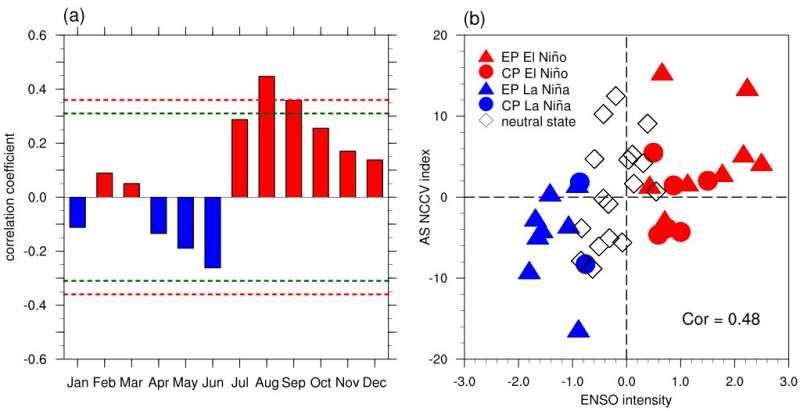This article has been reviewed according to Science X's editorial process and policies. Editors have highlighted the following attributes while ensuring the content's credibility:
fact-checked
trusted source
proofread
Researchers reveal how a key weather system in Northeast China is modulated by El Niño

Southern Oscillation (ENSO) is a recurring climate pattern involving changes in the temperature of waters in the central and eastern tropical Pacific Ocean.
It comprises two extreme phases, El Niño and La Niña (warming and cooling anomalies of the ocean surface, respectively, between which is a third phase called ENSO-neutral), and can be further split into two types depending on the location of the maximum anomalies: Classical ENSO is associated with maximum anomalies in the eastern equatorial Pacific and is therefore more commonly referred to as Eastern Pacific ENSO; while Central Pacific ENSO, which has occurred with increasing frequency in recent decades, has maximum anomalies in the central equatorial Pacific.
Meanwhile, an essential cyclonic circulation system over Northeast Asia, known as the Northeast China cold vortex (NCCV), has attracted wide attention owing to its considerable influence on weather and climate anomalies across central and eastern China. The association between the NCCV and ENSO is noteworthy.
In this context, researchers from Nanjing University of Information Science and Technology, China, found that late-summer NCCVs can be significantly modulated by previous-winter ENSO, with El Niño (La Niña) accompanied by a weak (strong) NCCV intensity. The paper has been published in Atmospheric and Oceanic Science Letters.
A significant correlation dominates the ENSO–NCCV relationship, which is suggested to be highly associated with the intensity and type of ENSO. Eastern Pacific–type El Niño tends to restrain the intensity of the NCCV, while La Niña contributes to a strengthening of the NCCV. Moreover, another mode of sea surface temperature anomalies—the Indian Ocean basin mode—is an essential intermediate factor in this modulation mechanism.
It is passive in response to ENSO and can last until late summer when the ENSO signal has already decayed. The triggered teleconnection patterns (teleconnections are significant relationships or links between widely separated weather and climate phenomena) enable a background circulation system conducive to NCCV generation. In addition, the signal of the Indian Ocean during Central Pacific–type El Niño and ENSO-neutral years is extremely weak, which makes the effect on NCCV generation inapparent.
"We found that NCCVs in late summer can be significantly modulated by previous-winter ENSO, mainly in terms of the influence of background circulation, and thereby contributes to the average NCCV intensity. However, the variations of NCCV in location, frequency, number of days, intensity, and pathway, are all extremely important to weather and climate anomalies. The influence of external forcings on the multi-scale evolution of NCCVs and the physical mechanisms involved deserve close attention in future work," explains Dr. Zhou, the corresponding author of the paper.
More information: Shuo Han et al, Modulation of the late summer Northeast China cold vortex by previous-winter ENSO, Atmospheric and Oceanic Science Letters (2023). DOI: 10.1016/j.aosl.2023.100371
Provided by Chinese Academy of Sciences




















